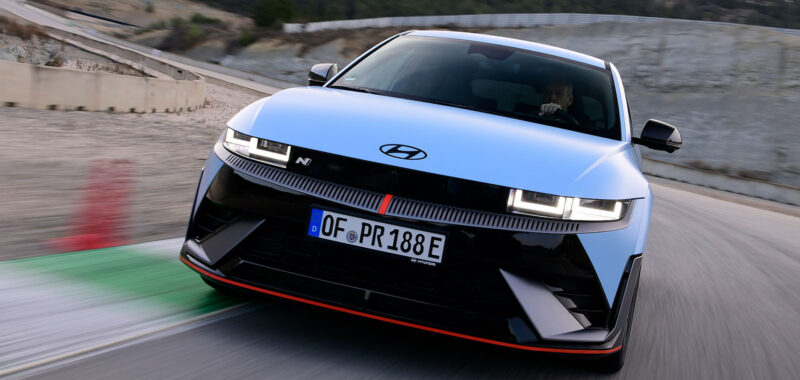With or without it the N’s dynamics are first rate, especially given this is a 2200kg performance car. As a result of the mass there is notable pitch under acceleration and roll in cornering, even with the dampers stiffened, but the steering weights up nicely to let you lean against it. You’d barely know the brakes are by-wire too. It could have more pedal resistance under heavy track braking, but then might feel too obstructive on the road.
Turn-in is good, particularly if you settle the nose first by trail braking. I don’t think a Porsche Taycan turns this well, or has this fantastic level of adjustability, even if you leave the power balance alone by not pitching the N into its rear-drive mode. The rear motor is more powerful than the front anyway, the tyres are 275/35 R21 Pirelli P Zeros all-around and the weight distribution must be fairly even.
As a result – and with stability control off, which N says means you’re entirely on your own – the Ioniq turns large mid-corner grip into a slide on corner exit. It even wants to ease into gentle oversteer in high-speed corners. The last Ford Focus RS did this, but not to this extent, and not this controllably either. It’s “not a drift car,” says Tyrone Johnson, “but it can be made to drift”. And it’s still great fun if you’re precise and don’t let it.
The drift optimiser is a novelty. Hyundai wettened a skid pan so we could play with it. The throttle response is too sharp to easily enter a prolonged slide, but as a way to practice car control it’s huge fun. Look out for viral videos of owners sliding into lamp posts in wet retail outlet car parks.
But the car is seriously satisfying on the road, too. European Ns have a softer damper setup than the original prototype we drove – Hyundai even does some tuning in the UK – but the vertical control unsuprisingly remains considerbly tighter than that of your standard Ioniq 5. Direction changes feel sharp and accurate, with pleasingly precise steering. There’s also good enough compliance and a keen edge to proceedings. As well as the Focus RS, there are hints of Mercedes-AMG A45 or even Mitsubishi Evo about it, though it’s more mature and multi-faceted than all of those. I’d drive this over most of them.
And sure, at 2.2 tonnes the N is no fairy, but a pedigree driving position and fine synthesis of steering behaviour, roll rates and throttle/brake response contrive to shrink it – certainly to the extent that you feel confident barrelling into bends, teasing the chassis. Pushed hard, the natural mid-corner balance neatly smudges all four tyres across the road surface while maintaining terrific momentum. It’s a bit like the old Volkswagen Golf R Estate in this sense, only with less adjustability on a lifted ‘throttle’ but more – much more – when back on the power.
As for isolation over longer distances, the 5 N is pretty compelling. Another key takeaway from our drive Castellolí Circuit and on the surrounding routes was that, in its softer damper setting, the Ioniq 5 N can be wonderfully laid back.
Just how laid back? It was telling when, after an afternoon on track, we hopped into another Ioniq 5 N for the dull run to the airport. Heading out along Castellolí’s access road, I caught myself thinking: “Ah, nice to be back in something quiet, comfy and gloriously undemanding.” But of course, it was the very same car, just in the default, sat-back drive mode rather than with all the N shenanigans ramped up.

